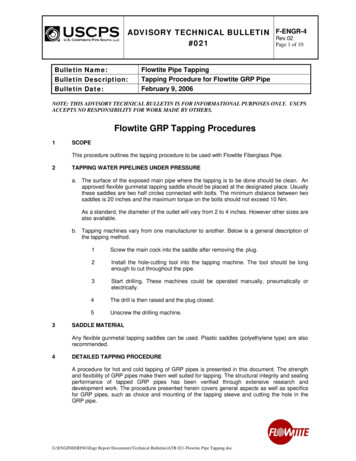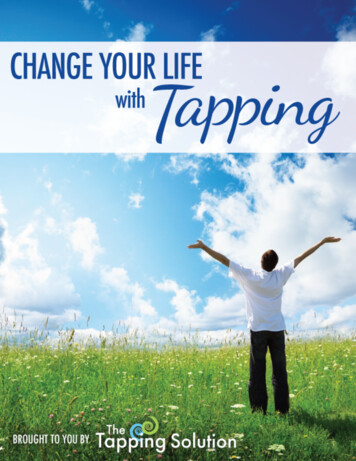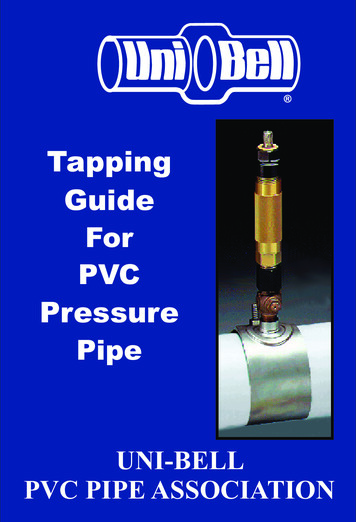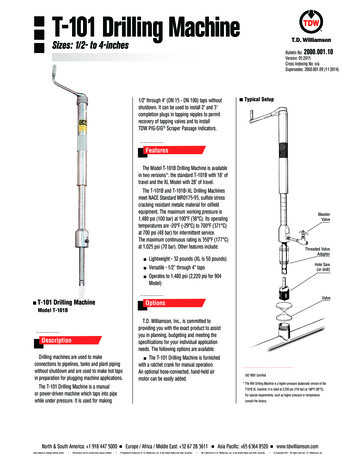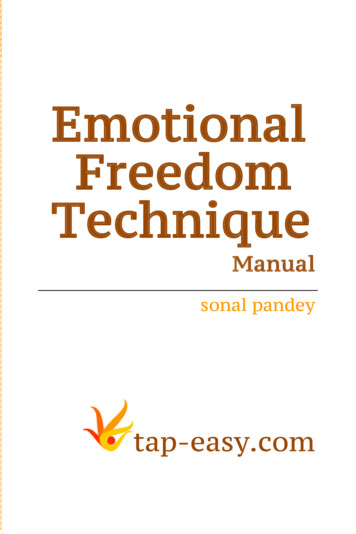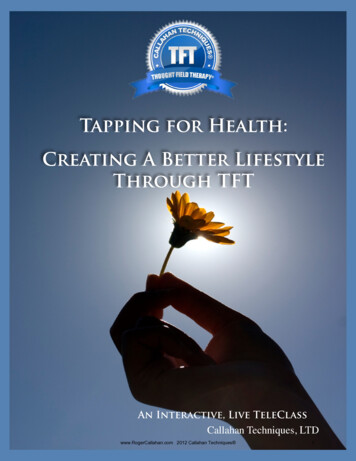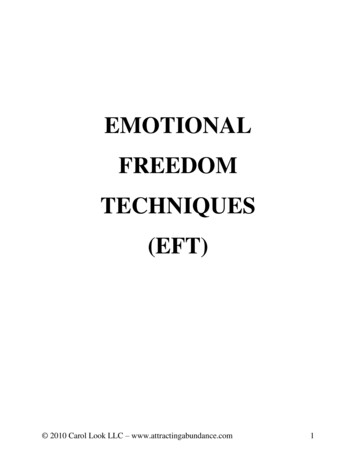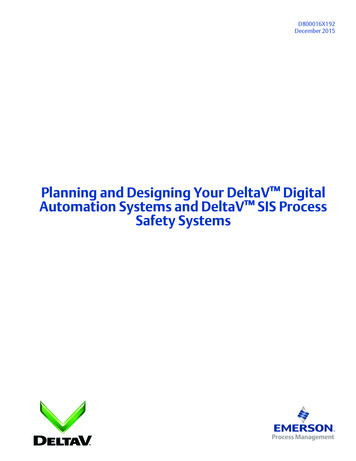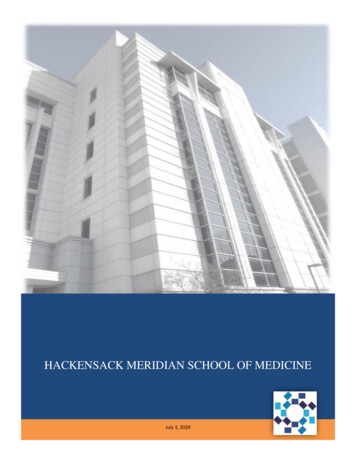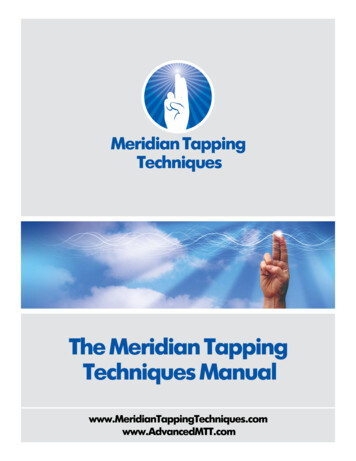
Transcription
Meridian TappingTechniquesThe Meridian TappingTechniques dMTT.com
TABLE OF CONTENTSMERIDIAN TAPPING TECHNIQUES (MTT) . 3USING FOCUSED TOUCH TO CALM . 5HISTORY . 6INNOVATIONS . 8RESEARCH . 9HOW DOES MTT WORK? . 9COMMON FACTORS . 10THE POINTS . 10OTHER POINTS . 11SHORT CUTS . 12FINGER POINTS . 13TRAUMA OFF SWITCH?. 13HOW TO TAP THE POINTS . 13CREATIVITY . 14LET’S TRY IT . 14BREATHING EXERCISE . 14CRAVING EXERCISE . 14DO I NEED TO SAY ANYTHING?. 15MAKING STATEMENTS . 16WHAT ELSE DO I NEED TO KNOW? . 16FOR PRACTITIONERS: . 17PICKING YOUR ISSUE . 17RESULTS GENERALIZE . 17GETTING SPECIFIC . 18WHEN NOT TO BE SPECIFIC . 19PHYSICAL RESPONSE . 20DECIDE HOW TO MEASURE YOUR ISSUE . 21MERIDIAN REVERSALS . 22ACCEPTANCE STATEMENT . 22THE WORK . 23OBJECTIONS TO SUCCEEDING . 24CORE BELIEFS . 25DO YOU EVER TAP FOR A POSITIVE?. 25CHECK YOUR RESULTS. 26TEST IT OUT . 26OTHER TOOLS. 27THE 9 GAMUT . 28THE 9 GAMUT PROCESS . 28MUSCLE TESTING . 28KNOW YOUR LIMITS . 29WHAT ABOUT THE RIGHT WORDS?. 29OPTIONS FOR COMPLEX REVERSALS. 29SORE SPOT . 30COLLARBONE BREATHING . 30THYMUS THUMP . 31CROSS CRAWL . 32MTT REVIEW . 321
OTHER HELPFUL ORGANIZATIONS. 33REFERENCES PLEASE FEEL FREE TO ADD OTHER IMPORTANT REFERENCES. . 33MUSCLE TESTING REFERENCES . 34ALGORITHMS – TAPPING POINTS . 342
Meridian Tapping Techniques (MTT)Meridian Tapping Techniques (MTT) covers all techniques thatutilize acupressure points to help decrease or resolve negativeemotions and emotionally based physical issues. Practitionersworldwide use these effective, dynamic techniques and teachthem to their clients to increase their self help skills.Meridian tapping is based on the concepts behind acupuncture.Acupuncture has been around for thousands of years and hasbeen an accepted medical method in the western world since the1970s. Acupuncture affects the energy that moves throughoutour body in pathways called meridians.Research by Robert Becker in the70’s reveals electrical resistance atmany acupoints, showing thatmeridians are electrical in nature. This and other research offersupport for an energy system in our body. This energy systemhas electromagnetic qualities, including light, sound and subtleelectrical current. Indeed, some accepted medical tests such asEKGs and EEGs measure the electrical output of our body.Meridian tapping techniques address this energysystem by tapping or touching various meridian points.Acupressure points are located where the meridianpathways are nearer to the skin’s surface. Hundreds ofacupressure points are utilized by acupuncturists totreat various pain and physical conditions. Theawareness in the 1970’s that these points could alsoaffect emotional and psychological factors heralded thebirth of Meridian Tapping Techniques.It is important for the energy to flow smoothly inour bodies. Any cause that blocks this flow willnegatively affect the energy in our body - likewater in a kinked garden hose. You can imaginethat these kinks, or blocks, have a large impacton our body and life. The job of MeridianTapping practitioners is to use methods thatrebalance your body’s energy, remove any stuckenergy flow and help clients maintain a smoothenergy flow.These techniques constitute a relatively newrelaxation and calming method that:3
increases mind-body awarenessreduces anxiety andenables faster positive cognitive shifts.Or, in simpler terms: These techniques are a terrific way to feelbetter, more relaxed, and able to think more objectively andpositively about the issues you face.If you are a health care professional just coming upon thesetechniques for the first time you are in for a surprise. MeridianTapping Techniques (MTT for short) can quickly calm an anxiousor fearful client. Even more, these techniques are generallyeffective for reducing, and many times eliminating, phobias andsymptoms of trauma. These techniques can be amazinglysuccessful. Many practitioners give antidotal reports of over 80%success rates.Maintaining the smooth energy flow in our body helps us to: Achieve our goals Alleviate stress Reduce fears and phobias Calm cravings Increase energy Decrease anxiety and panic attacks Manage anger Decrease or relieve pain Modify bad habits Instill positive beliefs and behaviorsYou may be aware of therapies such as Reiki,Homeopathy, Tai Chi etc. that work via the body’s energysystem. The difference with meridian tapping is that it isvery directed, targeted, and user-interactive and thustends to get very fast results.There are now thousands of physicians, chiropractors,naturopaths, homeopaths, nurses and other health careproviders who have added Meridian Tapping methodsskills to their tool box.Whether you are looking for the ultimate self-help tool foryourself or the best and most efficient ways to help yourclients, you’ve come to the right place.In addition to thousands of reports by satisfied users,there is now research available to verify the effectivenessof these techniques.Most new ideas take a while to be accepted in themainstream. This is as it should be. If the entirety of society accepted every new change4
immediately we would wake up to a new world everyday. All new innovations have their naysayers: There is no reason for individuals to have computers in their homes. Ken Olsen,Pres. Digital Equip. 1977When self adhesive stamps first came out we couldn’t give ‘em away! Postal Clerk1999Airplanes are interesting toys no military value. Marshall Foch 1911X-rays are a hoax. Lord Kelvin, British physicist 1900The telephone is amazing but who would want to use one?Rutherford Hayes, President 1876Tapping techniques are so effective that the movement is spreading by leaps and bounds.These techniques may be reaching ‘the tipping point’ where tapping will be considered anacceptable solution. But keeping the above ‘expert’ comments in mind remember that thereare still people in industrialized countries that STILL don’t have a computer, would rather lickstamps, have never have ridden in an airplane, have never had an x-ray, and refuse to get aphone! No matter how great any new idea is there are always some who will not see thevalue.USING FOCUSED TOUCH TO CALMMost people coming to these methods areinitially very skeptical. And rightly so.Thinking that tapping or touching certainmeridian points can actually be effective ataccomplishing ANYTHING – much lessresolving phobias and reducing the impact oftraumatic experiences – can seemoutlandish. Try to keep your skepticism atbay until you try these techniques foryourself.One of the best things about tapping is thatyou don’t have to believe it will work for it tobe effective; you have to just do it.Is it possible to use touch or tapping to calm us? Think about it.Touches are a common part of our day to day life. Often duringthe day, particularly when we are stressed or have an emotionalresponse to something, we tend to do things such as put ourhand on our chest, rub our temples, drum our fingers on ourchest or face or desk, scratch our head, rub our chin or underour nose. We put our hands or finger tips at points around oureyes. We put our head in our hands. We may bite lightly on ourfingers (some of us even bite our nails.) All these touchesbasically serve the unconscious purpose of helping to calm us.5
WHAT IF we could bring up what bothers us – on purpose?WHAT IF we could use these natural touches – on purpose - in aconscious way to calm us?With MTT you can. Read on for how.The purpose of Meridian Tapping Techniques is to recognize and appreciate all the varieties ofmethods utilizing the process of tapping or otherwise utilizing meridian points. Since MeridianTapping Techniques is a generic term it can not be registered or trademarked and is thereforeopen to all.Many of the techniques covered under the MeridianTapping Techniques umbrella have a great deal incommon. They all utilize various points on the bodythrough tapping, touching, etc., in order to resolve ordecrease emotional and physical distress. The goal is tobalance the energy system so the energy can flow freelyand can be available for healing. How each practitionergoes about this can vary widely.This manual will show you several short versions of MTTthat are used by individuals as a self help tool and bypractitioners wanting to utilize the most effective tools fortheir clients. All have a very high success rate.Pick one of the MTT options and give it a try. Chances are it will work for you. If it doesn’t, thismanual also gives you more options to increase the effectiveness of these methods for you.Options and alternatives and new ideas will be shared.Innovations are growing in MTT and many are listed on the re did all this come from? From threeinnovative men: a chiropractor, a psychiatrist and apsychologist. In the 70’s George Goodheart, achiropractor, combined the fields of acupuncture,Chiropractic, Physical Therapy and muscle testing.The concept of muscle testing was noted as earlyas 1949 (Kendall and Kendall). Goodheart foundthat by touching a spot on the body that neededadjusting, the body could make another muscle(such as the deltoid muscle in the arm) go weak Applied Kinesiology (AK). Goodheart found, too,that he could substitute simple manual pressure forneedles. He found that he could obtain the samebeneficial results by simply applying manual6
pressure to the acupuncture points, or by "percussing" or "tapping" on them; an advance whichmade this acupuncture-derived method accessible to many more people, since it was noninvasive. Goodheart taught his concepts to chiropractors and other interested professionals.John Diamond, M.D., an Australian psychiatrist, who hasdescribed himself as the first mental health professional to studyapplied kinesiology with Goodheart, wrote Behavioral Kinesiologyin 1979. Diamond had the light bulb idea that if the body wouldrespond to a physical need with muscle testing it could respond toan emotional or psychological need as well. In his book, hedescribed a connection between specific emotions and themeridians.In the early 80’s, Roger Callahan, a psychologist, and a formerand brief associate of Diamond, studied Diamond’s applications ofkinesiology to emotional problems and studied applied kinesiology(AK) with chiropractors David Walther and Robert Blaich. Callahan began using acupuncturemeridians with AK to treat phobias. He added modifications which led to treatments for otherpsychological problems. He called his process the CallahanTechniques which he later renamed Thought Field Therapy (TFT.)Callahan initiated many of the Meridian Tapping Techniques usedtoday. He believed that an energetic influence of ‘perturbations’ (i.e.disturbances in the energy system) are experienced when someoneis thinking about or experiencing a problem existing in a ‘thoughtfield’. He surmised that these perturbations were responsible foremotional disturbances. Basically his method involves assessmentof what Callahan called ‘psychological reversal’ and using muscletesting to ‘diagnosis’ the specific order of meridian points to betapped.Callahan developed a process he called the ‘9 Gamut’, the eye roll and collarbone breathingtechniques (see later in this manual) to increase the effectiveness of tapping points. Afterassessing the needs of 100’s of patients, Callahan noticed patterns of meridian points whichcould be more effectively used. He established a simpler and more popularized versionwithout muscle testing: the recipe style algorithms which were short cut versions of the full TFTdiagnostic process.Many students found these shorteralgorithms to be as effective as the timeconsuming muscle testing diagnostic methodand some students went on to develop theirown adaptations and techniques. All theinnovations were based on the premise thattapping on meridian points would balance theenergy system and thereby resolve emotionalissues. Students expanded with creativityand innovation on the concept that short cutversions were generally as effective as thelonger, more involved steps. Each developedtheir own process and single algorithm in7
isolation from the others. These innovators have now taught thousands of others their MTTversions. Now their students are going on to develop other innovations.Two key innovators were Dr.Patricia Carrington and GaryCraig. In 1987 Dr. Carringtondeveloped Acutap, a singlealgorithm that stimulated theendpoints of the 14 majormeridians by tapping 35 timeson each acupoint. Her algorithmdid not have any of thediagnostic components of TFT.Dr. Carrington went on todevelop other innovations suchas the Choices Method. Shehas DVDs and a newsletter that keeps subscribers informed of her most up to date changesand innovations: MeridianTappingTimes.com.Independent of Dr. Carrington’s method, in 1995, Gary Craig released his own single algorithmtapping method, Emotional Freedom Techniques, which also involved tapping all the meridiansin sequence. In addition to TFT, Gary Craig also studied Neurolinguistic Programming andadded concepts from NLP such as reframes, questioning and other story processingapproaches to EFT to simplify the identifying and addressing issues. He has a newsletter:EFT Insights, and training DVDs.Other early innovators in the meridian tapping field were:TAB – Touch and Breathe: John DiepoldBSFF – Be Set Free Fast: Larry NimsTEST – Thought Energy Synchronization Therapy: Greg NicosiaEdXTM – Energy Diagnostics and Treatment Method – Fred GalloNAEM – Negative Affect Erasing Method: Fred GalloIEP – Individualized Energy Psychotherapy: Gruder/Hover-KramerEvTFT – Evolving TFT: John DiepoldStill others, independently of Callahan, developed methods that used acupressure pointswithout tapping. For example, Tapas Acupressure Technique (TAT) developed by TapasFleming.INNOVATIONSGary Craig’s single algorithm method, EFT, a simplified version of TFT,leads the world in the development and teaching of the meridian tappingapproach to healing. He said in an interview: “There is no EFT withoutinnovations.” That statement could be generalized to cover any treatmentmethod.But are innovations to a method always necessary? If what you are doing is working, keepdoing it. If what you are doing is not working, or is working slowly, or doesn’t seem to work as8
well with some populations it is very helpful to have other options and creative ways to addressthe issue as well.There have been many, many innovations in Meridian Tapping. There are too many to listhere, although we attempt to list the most well known in the appendix and on the Resourcepage on our website.RESEARCHAll of these systems have amassed anecdotal evidence of their effectiveness. Research,however, is only beginning. Much more research into these methods is necessary before anymeridian tapping technique will be accepted into the mainstream of medicine or other fields.Most of the research projects to date use either a TFTalgorithm or the EFT short cut version. The Association forComprehensive Energy Psychology (ACEP) has an activecommittee pursuing research activities and at times offerssmall monetary grants to encourage research. Some ofthis research is very encouraging (e.g. studies showingpositive changes in the brain (using EEGs) after 12 TFTsessions, studies showing higher effectiveness, shortertreatment and longer lasting reductions of anxiety whenusing TFT verses cognitive behavioral therapy (a commontraditional treatment method), and studies showing theeffectiveness of EFT for reducing phobias of small animals.A comprehensive list of information about what research has been done and is in process canbe found on the ACEP web site: www.energypsych.orgHOW DOES MTT WORK?What actually causes our emotional upsets? Callahan believed thatall distress was caused by ‘perturbations’ or disturbances in the‘thought field’. Gary Craig believes that the cause is a disruption in theenergy system. Gallo felt that both explanations were too simplistic anddid not take into account the other systems of the body. He put it adifferent way: “Traumatic stress is created the moment we say “no” tothe present moment and the flow of life energy is blocked.” (Gallo(2009) in a speech to German audience.)Fred Galloemotional and oftenThe current, very basic answer to what causes – and what can fix –physical distress is: “no one really knows”.There are, however, four key theories that are being explored:1. Physiological – That existing biological mechanisms can explain ita. Ron Ruden - http://energypsych.org/article-ruden2.phpb. Judith Swack - http://energypsych.org/article-swack.phpc. Bruce Lipton - http://www.brucelipton.com2. Pattern Interruption – That post traumatic ‘fixations’ are interrupteda. http://www.bmsa-int.com (multi-sensory activation)9
3. Measurable Electromagnetic System – That our energy system interacts with ourphysiologya. http://ww.acubriefs.comb. Jim Oschman - http://www.energyresearch.bizland.com4. Non-Material Transfer or Quanum physicsa. William Tiller - http://tillerfoundation.com(From Diepold, et al. (2004) Evolving Thought Field Therapy: The Clinician’s Handbook ofDiagnoses, Treatment, and Theory).COMMON FACTORSWhat are the major factors in effectivetapping? What do all the methodshave in common? Three things: Focusing on (attuning to) anissue, emotion or physical painwhile doing the technique Tapping, touching, or intent totouch points along the meridians Balancing the energy systemAll the other variations and innovationssurrounding any Meridian TappingTechnique may be useful in helping getto an issue.THE POINTSMeridian Tapping Techniques utilizepoints along fourteen main meridians.The most common points used all arelocated near the endpoint of themeridian and near a bone to maximizethe percussion impact. Rarely are allpoints now used in a session. Themajority of MTT practitioners havefound that using less points often turnsout to be just as effective.The fourteen most common meridian points used are:IDName of PointDescriptionMeridianBladderEmotion ccupuncture)BL-2ebEyebrowBeginning ofEyebrow next tonoseoeSide of eyeouter corner ofGallrageGB-110
eUnder eyeunUnder noseChin Mid chineye socket on theboneUnder eye onedge of boneUnder lower lip,middle of chinjust below eithercollar bone rningVesselCentralvesselKidneyembarrassment GV-26 or 27SpleenshameCV-24grief, anxiety,insecurityK-27anxiety, fear offuture, selfesteemSpleen 17Lung 11ccollarboneaArm4” under arm pitabout nipple level(bra strap level)ThThumbBody side ofLungthumb nail at baseintolerance,arroganceifIndex fingerguiltmfMiddle fingerBody side of index Largefinger at baseIntestineBody side ofCirculationmiddle finger atbaselfLittle fingerLivBreast spotGGamut spotshSide of handor Karate spotBody side of littlefinger at base1” below thenipple*jealousy,addictivecravingsPenicardium 9heartangerHeart 9liverunhappinessLiverThyroidLittle finger side ofhandStomach 1SmallIntestinesadness,reversalsTriple Warmer3SI-1 or 3*(because of the difficulty of reaching this point most either omit using it or use a point lower onthe midriff.)OTHER POINTSSome innovators, like James Durlacher, a colleague of Callahan’s who developed Acu-Power,and Fred Gallo, added more points to the above. Others, like Steve Reed (REMAP), tap onone point on the meridian as long as there is movement and go to the next point on the samemeridian until the issue is resolved. The points he uses are: Just above bridge of nose - Bladder 1just in front of the earmiddle of end of eyebrowside of nostriljust up over nipple on chest11
above last point nearer the shoulderThird Eye – mid forehead – glabella (GV-24.5)Thymus point – mid chest above thymus gland (CV -20)Other practitioners have included points such as: Top of the head – between ears Wrist points Inside of the knee Ankle pointsOur goal in making this list is to point out that there are manymeridian points and types of sequences used successfully bypractitioners. Each has a favorite way of tapping.We encourage you to find additional information and study amethod that resonates with you. There is not just one correctway to use tapping methods. There are many helpfulapproaches and techniques. There are many excellentpractitioners. Some practitioners use these methods as an adjunct to their traditional methodsand others use only meridian tapping in their practice. If you are looking for a practitioner,Patricia Carrington has written an article that can be helpful: What Questions Should You AskWhen Seeking an EFT EFTPractitioner.htmlIt Doesn’t Really Matter! In the above list we have inserted the emotions that John Diamondattached to the point. Knowledge of these links can be helpful. Bear in mind, however, thatthis is not a ‘carved in stone’ list. Most practitioners do “rounds” of tapping on the same 7-10points as the work with emotions and events. Use references as guidelines not as laws. Keepyour mind and eyes open to other possibilities.SHORT CUTSMultiple ‘short cut’ (i.e. not using all the points listedabove) methods have been explored by others.The shortest of the short cuts is ONE point. Find thepoint that is most effective for you by paying closeattention to your reaction when tapping or holdingeach of the meridian points. If you are noticing a shifton one point try just staying on that point until you nolonger notice any change before you move on to thenext point. Notice what point (or points) seemed tohave the most impact – the most effective response.Try focusing on your issue and just using that point.When the intensity level of your issue no longerreduces, add in more points.Callahan felt that each emotion or problem required adifferent sequence of some or all of the points. His‘short cut’ algorithms were identified as patterns forcertain emotions. However, sometimes there are12
multiple and/or conflicting emotions and it is difficult to differentiate one emotion from another.Gary Craig (EFT) felt that diagnosing the order of the points according to the issue was notnecessary. He, and others like Dr. Carrington, tried tapping just some or all of the points in thesame order no matter what the problem was.FINGER POINTSFinger points are not often used by most MTTpractitioners. Other tapping methods, however, useonly the finger points. However, even if you don’t usethe finger points as a part of a regular sequence theyare terrific for ‘stealthy tapping.’ For instance, you cantap the finger points under the table in a meeting or tapfingers on the wheel while driving. Remember thefinger points are on the body side of the nail on thebottom right of the nail bed.TRAUMA OFF SWITCH?Did you ever wonder why people can become traumatized in the wink of an eye and take years– or never – to get over it? These Meridian Tapping Techniques could be an off switchUsing these Techniques allows you to release thenegative emotions surrounding an event. It doesnot remove the memory of the event.It does not remove normal, natural, healthy emotions. It does not remove emotions thatrealistically protect you. It does not re
Acupressure points are located where the meridian pathways are nearer to the skin’s surface. Hundreds of acupressure points are utilized by acupuncturists to treat various pain and physical conditions. The awareness in the 1970’s that these points could als
